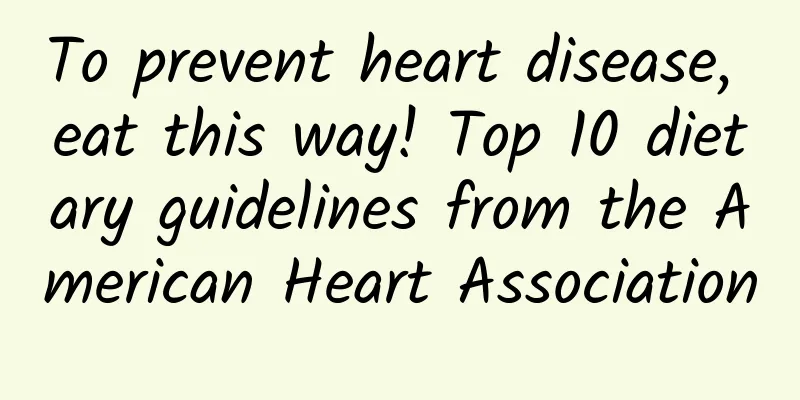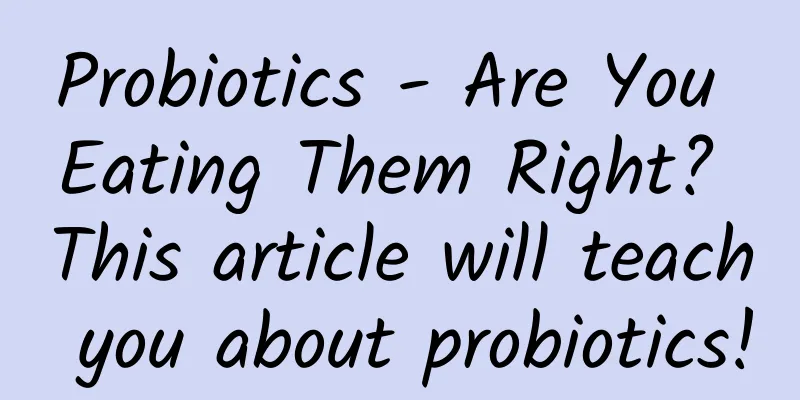To prevent heart disease, eat this way! Top 10 dietary guidelines from the American Heart Association

|
Recently, the American Heart Association published dietary guidelines for preventing heart disease, which emphasize the importance of paying attention to the overall dietary pattern rather than just emphasizing a certain food or nutrient. The guidelines show that no matter what stage of life, we can all benefit from a heart-healthy diet, and that it can be modified to suit personal preferences, lifestyle, and cultural norms. It doesn't have to be complicated, time-consuming, or expensive, or boring. In addition, whether you cook at home or order takeout, you can follow a healthy eating pattern, "and you can adapt a heart-healthy eating pattern to different lifestyles." Dietary patterns refer to the balance, variety, amount, and combination of food and beverages regularly consumed. The new guidelines point out that maintaining a healthy diet throughout life is beneficial to health, while low-quality diet increases the risk of cardiovascular disease and death. It also summarizes the ten characteristics of a diet that prevents heart disease: 1. Balance between eating and exercise: Exercise regularly to balance diet and calories and maintain a healthy weight; 2. Rich variety: Eat a rich diet, eat more vegetables and fruits, and get comprehensive nutrition from food instead of taking dietary supplements; 3. Eat less refined grains: Choose whole grains or foods made from whole grains; 4. High-quality protein: Include healthy lean meats and/or high-fiber proteins in your diet, such as plant protein (nuts and beans), fish and seafood, and low-fat or fat-free dairy products, and limit red meat and processed meat. 5. Healthy oils: Eat oils extracted from non-tropical plants such as olive oil or sunflower oil in moderation. 6. Fresh food: Choose minimally processed foods instead of ultra-processed foods whenever possible; Processed foods include meats that have been preserved by smoking, salting or adding preservatives, and plant foods that have added salt, sugar or fat. Ultra-processed foods are foods that have artificial colors, flavors and preservatives in addition to added salt, sweeteners or fat. 7. Eat less sweets: Try to eat less sugary drinks and foods; 8. Eat less salty food: Choose or prepare food with less or no salt; 9. Limit alcohol consumption: If you don’t have a habit of drinking, don’t start drinking; 10. Dietary Rules: No matter where you eat, you can follow this guideline. It also emphasizes the important role of health education, believing that healthy eating should be emphasized early in life and maintained throughout life. It also explores the social and other challenges that may exist in maintaining a heart-healthy eating pattern. For the first time, the guidelines also take into account the environmental sustainability of healthy food. Commonly consumed animal foods, especially red meat (beef, lamb, pork, veal, venison or goat), have the greatest environmental impact in terms of water and land use, and contribute significantly to greenhouse gas emissions. Therefore, shifting diets away from meat and toward plant-based proteins would also help improve the environment. The guidelines believe that promoting a heart-healthy diet is a win-win for individual health and environmental protection. Promoting healthy eating is not something that can be achieved overnight. There are many obstacles: false dietary information circulating on the Internet; lack of nutrition education in schools and medical schools; food and nutrition insecurity; inappropriate advertising; and dietary issues that are permeated with racism. "Creating an environment that promotes and supports everyone's adherence to heart-healthy dietary patterns is a public health priority," the guidelines state. Source: China Circulation Magazine |
>>: What harm has human beings brought to the ocean? What is deep in the ocean?
Recommend
Clear fluid coming out of breast during pregnancy
After a woman becomes pregnant, some transparent ...
Does 15mm of uterine rectal fluid accumulation need treatment?
Uterine rectectomy is the accumulation of fluid i...
Washing with baking soda can easily give birth to a boy
Whether to have a boy or a girl is not something ...
Bad temper and irritability during pregnancy
Nowadays, people are under great pressure in thei...
Negative pregnancy pictures
In order to quickly know whether they are pregnan...
Painful urination and blood in urine the day after intercourse
During the pregnancy preparation period, we have ...
What happens if you take cold medicine during pregnancy?
Everyone knows that you cannot take medicine duri...
Whether a woman is dirty or not depends on this place
Washing your face, brushing your teeth, taking a ...
Is vaginal bulging during pregnancy dangerous?
The process of pregnancy is not easy. Every pregn...
Can pregnant women twist the neck?
Pulling the neck is also called twisting the neck...
Treatment of moderate atypical endometrial hyperplasia
Gynecological diseases are very harmful to women....
Can pregnant women with allergies apply ointment?
Everyone knows that skin allergies generally need...
What to do if your toes itch during pregnancy
Pregnant women have relatively weak body resistan...
What is the cause of uterine cold?
Uterine cold means cold uterus. Uterine cold will...









